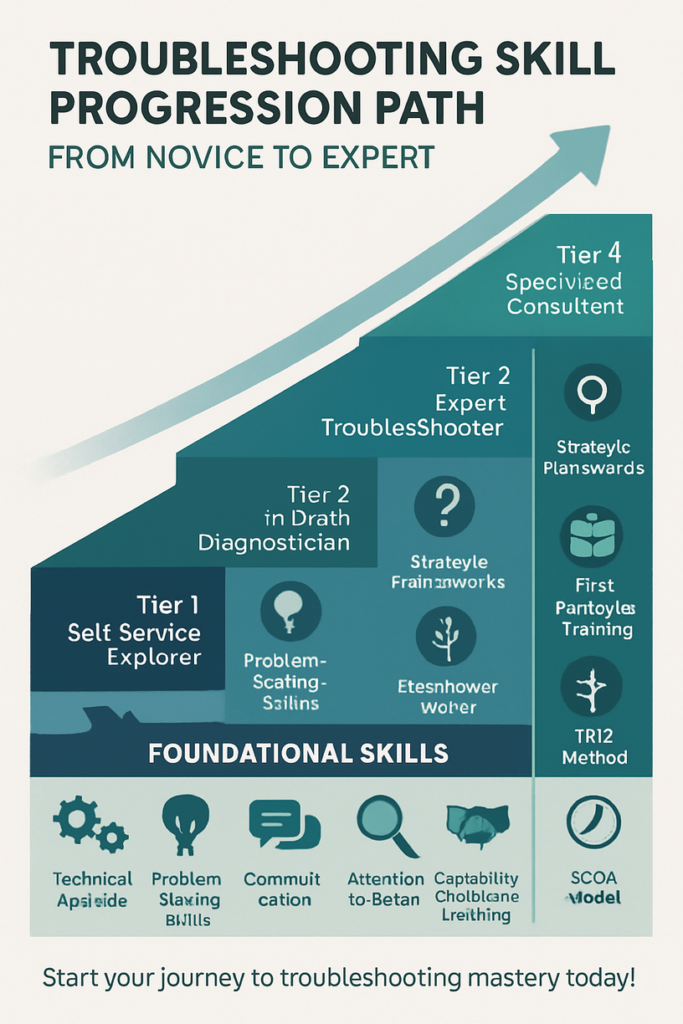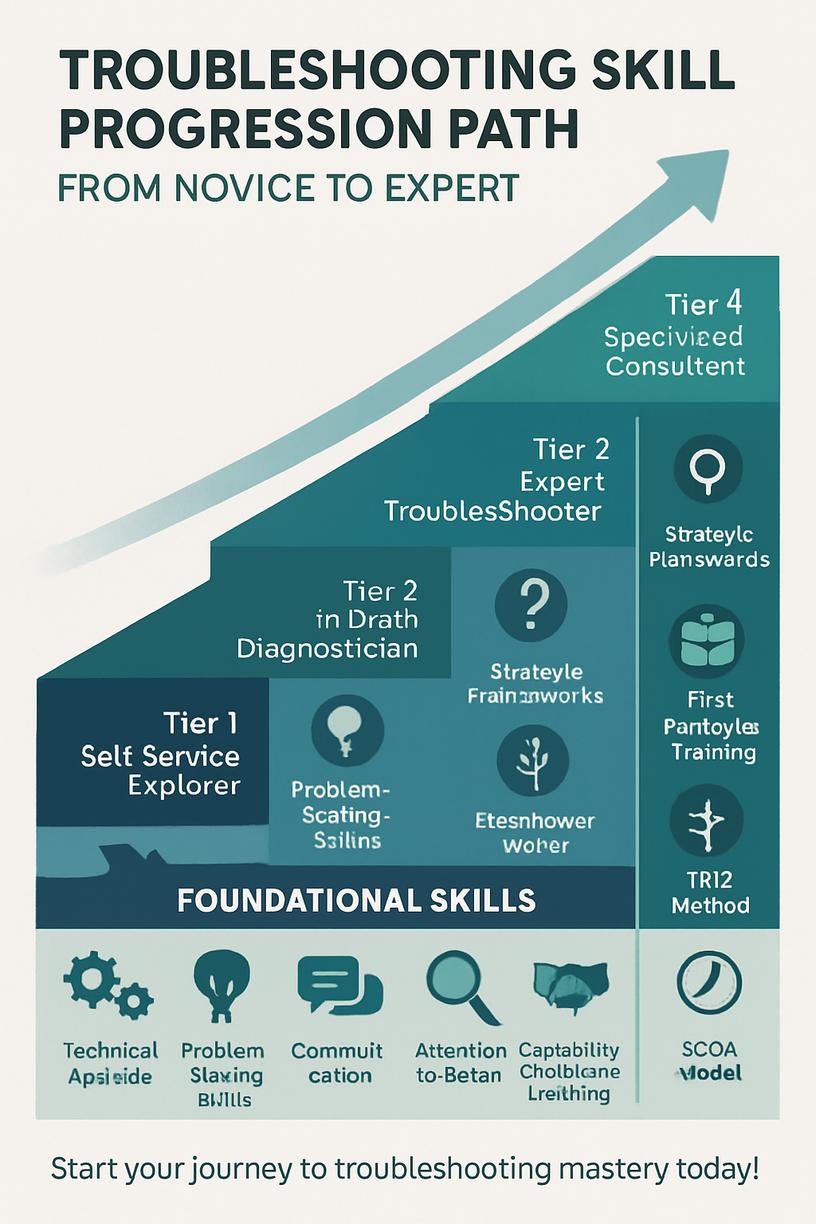
In today’s fast-paced world, where technology underpins nearly every aspect of our lives,
The ability to troubleshoot effectively is more than just a technical skill—it’s a superpower.
Whether you’re an IT professional, a developer, or simply someone who relies on digital tools, encountering problems is inevitable.
The true differentiator lies in how efficiently and effectively you can resolve them.
Troubleshooting isn’t just about fixing what’s broken; it’s a methodical process of investigation, diagnosis, and resolution.
It’s about understanding systems, anticipating failures, and applying logical steps to restore functionality.
But how does one evolve from a novice who fumbles through solutions to an expert who can swiftly pinpoint and resolve complex issues?
It’s a journey, a progression path that involves continuous learning, practical application, and a deep understanding of problem-solving methodologies.
In this blog post, we’ll explore the various stages of troubleshooting skill progression, delve into the core competencies required at each level,
and introduce you to powerful frameworks that can accelerate your journey from a basic problem-solver to a troubleshooting maestro.
Get ready to unlock your inner detective and master the art of technical problem-solving!
The Foundational Skills:
Building Your Troubleshooting Toolkit

Before we dive into the progression levels, let’s talk about the bedrock of all effective troubleshooting: the foundational skills.
Think of these as the essential tools in your problem-solving toolkit.
Without them, even the most advanced frameworks won’t be as effective.
I’ve found that mastering these basics is crucial for anyone looking to excel in this field.
First and foremost, Technical Aptitud is non-negotiable.
You need a solid understanding of the systems you’re working with—be it hardware, software, operating systems, or networks.
It’s like a doctor knowing anatomy; you can’t fix something if you don’t understand how it’s supposed to work.
This isn’t about memorizing every detail, but rather grasping the core concepts and interdependencies [1].
Next up is Problem-Solving Skills.
This might sound obvious, but it’s about more than just finding a solution.
It involves logically analyzing symptoms, isolating the root cause, and then devising effective solutions.
It’s a systematic approach, not a shot in the dark. I always tell people to think like a detective, gathering clues and eliminating possibilities [1].
Communication is often overlooked, but it’s incredibly vital.

Videos are added as random thoughts 💭 💭 💭.
You need to be able to explain complex technical issues clearly to users who might not have your technical background.
Equally important is actively listening to users to accurately understand their problems.
And don’t forget documentation! Keeping records of problems and solutions builds a valuable knowledge base for future troubleshooting [1].
Then there’s Attention to Detail. Small oversights can lead to big problems in troubleshooting.
Careful observation and methodical work are required to prevent and resolve issues efficiently.
I’ve seen countless times where a tiny detail, easily missed, was the key to unlocking a solution [1].
Finally, Adaptability and Continuous Learning are paramount.
Technology changes at a dizzying pace, and what worked yesterday might not work today.
Effective troubleshooters stay updated with new tools, systems, and techniques.
It’s a never-ending journey of learning, and that’s what makes it so exciting [1].
And let’s not forget Customer Service.
Patience, empathy, and professionalism are crucial when assisting users who are often frustrated or stressed.
A calm and understanding demeanor can make all the difference [1].
The Progression Path:
Levels of Troubleshooting Expertise
Just like any other skill, troubleshooting proficiency grows with experience and dedicated practice.
It’s not a sudden leap but a gradual climb through different levels of expertise.
I like to think of it in terms of IT support tiers, as they provide a clear framework for understanding this progression [2].
Tier 0 (L0) – The Self-Service Explorer: At this initial stage, individuals are empowered to solve problems on their own.
This often involves consulting FAQs, digital resources, and community forums.
Think of it as the first line of defense, where users try to find answers before escalating.
This level highlights the importance of well-documented solutions and accessible knowledge bases [2].
Tier 1 (L1) – The Basic Problem Solver: This is where direct human interaction begins.
L1 support personnel handle basic customer issues, often following scripts or established procedures.
Their goal is to quickly resolve common problems and, if a solution isn’t readily available, to smoothly escalate the issue to a higher tier.
This level emphasizes good communication and adherence to processes [2].
Tier 2 (L2) – The In-Depth Diagnostician:
As you progress to L2, the complexity of issues increases.
L2 staff possess a higher level of expertise and deeper knowledge of systems, applications, and common problems.
They engage in more in-depth troubleshooting and time-intensive problem-solving for less common issues.
This stage requires strong analytical skills and the ability to go beyond the obvious [2].
Tier 3 (L3) – The Expert Troubleshooter:
This is the realm of true experts. L3 support addresses complex, rare issues that L0, L1, and L2 teams couldn’t resolve.
These individuals often have extensive knowledge of the product or service, capable of conducting extensive root cause analysis.
They might even be involved in product design or development, using their deep understanding to untangle the most challenging problems [2].
Tier 4 (L4) – The Specialized Consultant: While not always an internal progression, L4 often involves bringing in external specialists, vendors, or consultants for highly specialized issues.
This level is about leveraging proprietary tools, unique expertise, or deep knowledge of specific technologies that might not be available in-house.
It underscores the idea that even experts know when to seek outside help [2].
This tiered approach isn’t just for IT support; it’s a mental model you can apply to any domain where troubleshooting is required.
It shows that mastery is a journey, built on a foundation of core skills and refined through tackling increasingly complex challenges.
Problem-Solving Frameworks:
Your Strategic Compass
Beyond individual skills, mastering troubleshooting involves adopting strategic frameworks that guide your approach to complex problems.
These aren’t just theoretical concepts; they are practical tools that I’ve personally found invaluable in navigating tricky situations.
They help you think systematically, prioritize effectively, and uncover the true essence of a problem [3].
1. The SCQA Model (Situation, Complication, Question, Answer):
This framework is about defining the problem clearly before jumping into solutions.
It forces you to articulate the current situation, identify the complication or challenge, formulate a precise question, and then propose a clear answer.
I use this all the time to ensure everyone is on the same page about what we’re actually trying to solve [3].
2. First Principles Thinking: This is about deconstructing problems to their fundamental truths and rebuilding solutions from the ground up, challenging assumptions along the way.
Instead of relying on how things have always been done, you ask:
‘What are the absolute basic, undeniable truths here?’ It’s a powerful way to innovate and find truly novel solutions [3].
3. The Eisenhower Matrix (Urgent/Important):
In the thick of troubleshooting, it’s easy to get sidetracked by urgent but unimportant tasks.
This matrix helps you prioritize by categorizing tasks into four quadrants:
Urgent & Important, Important but Not Urgent, Urgent but Not Important, and Neither Urgent Nor Important.
It’s a lifesaver for focusing on what truly matters and avoiding distractions [3].
4. The 5 Whys Method: This deceptively simple yet incredibly effective technique involves asking ‘Why?’
five times (or more) to uncover the root cause of a problem.
Instead of just treating symptoms, you dig deeper until you find the underlying issue.
I’ve seen this method reveal surprising insights and prevent recurring problems [3].
5. The TRIZ Method (Theory of Inventive Problem Solving):
This advanced framework encourages you to adapt solutions from other industries or contexts.
It’s about recognizing that many problems have already been solved elsewhere, and you can leverage those existing solutions by applying universal innovation principles.
It’s a fantastic way to think outside the box and bring fresh perspectives to your troubleshooting [3].
By integrating these frameworks into your troubleshooting process, you move beyond reactive problem-solving to a more proactive, strategic approach.
They provide a roadmap, helping you navigate complexity and arrive at effective, sustainable solutions.
Conclusion:
Your Journey to Troubleshooting Mastery
Troubleshooting is a dynamic and evolving skill, essential in our increasingly complex world.
It’s a journey that begins with foundational technical and soft skills, progresses through various levels of expertise, and is significantly enhanced by the strategic application of problem-solving frameworks.
From the basic steps of identifying a problem to the advanced art of root cause analysis,
every step you take on this progression path makes you a more valuable asset.
Remember, troubleshooting isn’t just about fixing things;
it’s about continuous learning, critical thinking, and a relentless pursuit of understanding.
Embrace the challenges, learn from every problem you encounter, and systematically build your skills.
The path to troubleshooting mastery is an exciting one, filled with opportunities to grow, innovate, and make a real impact.
So, what are you waiting for?
Start applying these skills and frameworks today, and watch yourself transform into the troubleshooting maestro you were meant to be!
